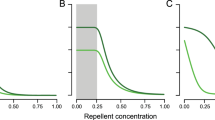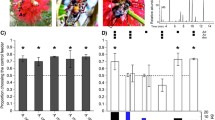Abstract
Olfactory signals, a major means of communication in insects, travel in the form of turbulent odor plumes. In terrestrial environments, an odor blend emitted from a single point source exists in every strand of the plume, whereas, in confluent plumes from two different odor sources, the strands have some chance of being coincident and comprising a new third odor in those strands. Insects have the ability to detect and interpret necessary olfactory information from individual filamentous odor strands in complex multifilament odor plumes. However, behaviorists have had no way to measure the stimulus situations they are presenting to their temporally acute insect subjects when performing Y-tube olfactometer or confluent pheromone plume wind tunnel assays. We have successfully measured the degree of plume-strand mixing in confluent plumes in a wind tunnel by using a multichannel insect-antenna-based chemosensor. A PC-based computer algorithm to analyze antennal signals from the probe portion of the system performed real-time signal processing and, following a short training session, classified individual odorant/mixture strands at sub-second temporal resolution and a few tens of millimeters of spatial resolution. In our studies, the chemosensor classified a higher frequency of strands of two different odorants emitted from two closely spaced filter papers as being “mixed” when the sources were located only 1 or 2 cm apart than when the sources were 5 or 10 cm apart. These experiments demonstrate the chemosensor’s potential to be used for measuring odor stimulus situations in more complex multiple-plume environments.








Similar content being viewed by others
References
Angioy, A. M., Desogus, A., Barbarossa, I. T., Anderson, P., and Hansson, B. S. 2003. Extreme sensitivity in an olfactory system. Chem. Senses 28:279–284.
Baker, T. C., and Haynes, K. F. 1989. Field and laboratory electroantennographic measurements of pheromone plume structure correlated with oriental fruit moth behaviour. Physiol. Entomol. 14:1–12.
Baker, T. C., Fadamiro, H. Y., and Cossé, A. A. 1998. Moth uses fine tuning for odour resolution. Nature 393:530.
Bau, J., Justus, K. A., and Cardé, R. T. 2002. Antennal resolution of pulsed pheromone plumes in three moth species. J. Insect Physiol. 48:433–442.
Bau, J., Justus, K. A., Loudon, C., and Cardé, R. T. 2005. Electroantennographic resolution of pulsed pheromone plumes in two species of moths with bipectinate antennae. Chem. Senses 30:771–780.
Drake, M. A., Gerald, P. D., Kleinhenz, J. P., and Harper, W. J. 2003. Application of an electronic nose to correlate with descriptive sensory analysis of aged cheddar cheese. Lebensm. Wiss Technol. Food 36:13–20.
Fadamiro, H. Y., Cossé, A. A., and Baker, T. C. 1999. Fine-scale resolution of closely spaced pheromone and antagonist filaments by flying male Helicoverpa zea. J. Comp. Physiol. A 185:131–141.
Hardie, J., Visser, J. H., and Piron, P. G. M. 1994. Perception of volatiles associated with sex and food by different adult forms of the black bean aphid, Aphis fabae. Physiol. Entomol. 19:278–284.
Hetling, J. R., Myrick, A. J., Park, K. C., and Baker, T. C. 2003. Odor discrimination using a hybrid-device olfactory biosensor, pp. 146–149, in Proceedings, First International IEEE EMBS Conference on Neural Engineering, Capri Island, Italy.
Huotari, M., and Mela, M. 1996. Blowfly olfactory biosensor’s sensitivity and specificity. Sensor Actuat. B Chem. 34:240–244.
Johnson, R. A., and Wichern, D. W. 1992. Applied Multivariate Statistical Analysis. Prentice Hall, Upper Saddle River.
Justice, K. A., Cardé, R. T., and French, A. S. 2005. Dynamic properties of antennal responses to pheromone in two moth species. J. Neurophiol. 93:2233–2239.
Krishnan, T. 2001. Imperfect supervision in statistical pattern recognition, pp. 25–65, in S. P. Pal, and A. Pal (eds.). Pattern Recognition from Classical to Modern ApproachesWorld Scientific, River Edge.
Kuwana, Y., and Shimoyama, I. 1998. A pheromone-guided mobile robot that behaves like a silkworm moth with living antennae as pheromone sensors. Int. J. Robot. Res. 17:924–933.
Kuwana, Y., Nagasawa, S., Shimoyama, I., and Kanzaki, R. 1999. Synthesis of the pheromone-orientated behaviour of silkworm moths by a mobile robot with moth antennae as pheromone sensors. Biosens. Bioelectron. 14:195–202.
Liu, Y. B., and Haynes, K. F. 1992. Filamentous nature of pheromone plumes protects integrity of signal from background chemical noise in cabbage looper moth, Trichoplusia ni. J. Chem. Ecol. 18:299–307.
Myrick, A. J., Baker, T. C., Park, K. C., and Hetling, J. R. 2005. Bioelectric artificial nose using four-channel moth antenna biopotential recordings, pp. 313–316, in Proceedings, 2nd International IEEE EMBS Conference on Neural Engineering, Arlington, Virginia, USA.
Myrick, A. J., Park, K.-C., Hetling, J. R., and Baker, T. C. 2008. Real-time odor discrimination using a bioelectronic sensor array based on the insect electroantennogram. Bioinspir. Biomim. 3:046006.
Nikonov, A. A., and Leal, W. S. 2002. Peripheral coding of sex pheromone and a behavioral antagonist in the Japanese beetle, Popillia japonica. J. Chem. Ecol. 28:1075–1089.
Ochieng, S. A., and Baker, T. C. 2002. Host plant volatiles synergize responses of sex pheromone-specific olfactory receptor neurons in male Helicoverpa zea. J. Comp. Physiol. A 188:325–333.
Park, K. C., and Hardie, J. 1998. An improved aphid electroantennogram. J. Insect Physiol. 44:919–928.
Park, K. C., Ochieng, S. A., Zhu, J., and Baker, T. C. 2002. Odor discrimination using insect electroantennogram responses from an insect antennal array. Chem. Senses 27:343–352.
Rains, G. C., Tomberlin, J. K., D’Alessandro, M., and Lewis, W. J. 2004. Limits of volatile chemical detection of a parasitoid wasp, Microplitis croceipes, and an electronic nose: a comparative study. T. Am. Soc. Agric. Eng. 47:2145–2152.
Sauer, A. E., Karg, G., Koch, U. T., Kramer, J. J. D., and Milli, R. 1992. A portable EAG system for the measurement of pheromone concentrations in the field. Chem. Senses 17:543–553.
Schaller, E., Bosset, J. O., and Escher, F. 1998. ‘Electronic noses’ and their application to food. Lebensm. Wiss. Technol. Food 31:305–316.
Schöning, M. J., Schütz, S., Riemer, A., Weißbecker, B., Steffen, A., Kordoš, P., Lüth, H., and Hummel, H. E. 1998. A BioFET on the basis of insect antennae. Sensor Actuat. B Chem. 47:234–237.
Schöning, M. J., Schroth, P., and Schütz, S. 2000. The use of insect chemoreceptors for the assembly of biosensors based on semiconductor field-effect transistors. Electroanalysis 12:645–652.
Schroth, P., Schöning, M. J., Kordoš, P., Luth, H., Schütz, S., Weißbecker, B., and Hummel, H. E. 1999. Insect-based BioFets with improved signal characteristics. Biosens. Bioelectron. 14:303–308.
Schütz, S., Weißbecker, B., Koch, U. T., and Hummel, H. E. 1999. Detection of volatiles released by diseased potato tubers using a biosensor on the basis of intact insect antennae. Biosens. Bioelectron. 14:221–228.
Theodoridis, S., and Koutroumbas, K. 1999. Pattern Recognition. Academic, San Diego.
Todd, J., and Baker, T. C. 1999. Function of peripheral olfactory organs, pp. 67–96, in B. S. Hansson (ed.). Insect OlfactionSpringer, Berlin.
van der Pers, J. N. C., and Minks, A. 1998. A portable electroantennogram sensor for routine measurements of pheromone concentrations in greenhouses. Entomol. Exp. Appl. 87:209–215.
van Giessen, W. A., Fescemyer, H. W., Burrows, P. M., Peterson, J. K., and Barnett, O. W. 1994. Quantification of electroantennogram responses of the primary rhinaria of Acyrthosiphon pisum (Harris) to C4–C8 primary alcohols and aldehydes. J. Chem. Ecol. 20:909–927.
Vickers, N. J. 2006. Winging it: moth flight behavior and responses of olfactory neurons are shaped by pheromone plume dynamics. Chem. Senses 31:155–166.
Vickers, N. J., and Baker, T. C. 1992. Male Heliothis virescens sustain upwind flight in response to experimentally pulsed filaments of their sex-pheromone. J. Insect Behav. 5:669–687.
Vickers, N. J., and Baker, T. C. 1994. Reiterative responses to single strands of odor promote sustained upwind flight and odor source location by moths. Proc. Natl. Acad. Sci. U. S. A. 91:5756–5760.
Vickers, N. J., and Baker, T. C. 1997. Chemical communication in heliothine moths. VII. Correlation between diminished responses to point-source plumes and single filaments similarly tainted with a behavioral antagonist. J. Comp. Physiol. 180:523–536.
Vickers, N. J., Christensen, T. A., Baker, T. C., and Hildebrand, J. G. 2001. Odour-plume dynamics influence the brain’s olfactory code. Nature 410:466–470.
Visser, J. H., and Piron, P. G. M. 1997. Olfactory antennal responses to plant volatiles in apterous virginoparae of the vetch aphid Megoura viciae. Entomol. Exp. Appl. 77:37–46.
Visser, J. H., Piron, P. G. M., and Hardie, J. 1996. The aphids’ peripheral perception of plant volatiles. Entomol. Exp. Appl. 80:35–38.
Walt, D. R., Dickinson, T., White, J., Kauer, J., Johnson, S., Engelhardt, H., Sutter, J., and Jurs, P. 1998. Optical sensor arrays for odor recognition. Biosens. Bioelectron. 13:697–699.
Witzgall, P., and Priesner, E. 1991. Wind tunnel study on an attraction inhibitor in male Coleophora laricella Hbn. (Lepidoptera: Coleophoridae). J. Chem. Ecol. 17:1355–1362.
Acknowledgements
We dedicate this paper to the late Dr. Jan van der Pers of Syntech (Hilversum, The Netherlands) for his passionate devotion to developing wonderful research tools for insect olfaction and for providing a basis, through his lifelong research and technology development efforts, for understanding the rudiments of insect pheromone and host-odor olfaction. We also thank Bryan Banks, Penn State University, for rearing the test insects and Drs. Junwei Zhu and Samuel Ochieng for helpful comments related to earlier versions of this study. This research was funded initially by the Controlled Biological Systems Program of Defense Advanced Research Projects Agency (DARPA) and subsequently by the Office of Naval Research (ONR) and the Defense Threat Reduction Agency (DTRA), through grants to TCB at Iowa State University (DARPA) and at Penn State University (ONR Counter-IED Program; DTRA). This research was also supported by a Keystone Alliance grant from the State of Pennsylvania, through Penn State University. The authors gratefully acknowledge the funding support from these sources.
Author information
Authors and Affiliations
Corresponding author
Rights and permissions
About this article
Cite this article
Myrick, A.J., Park, K.C., Hetling, J.R. et al. Detection and Discrimination of Mixed Odor Strands in Overlapping Plumes Using an Insect-Antenna-Based Chemosensor System. J Chem Ecol 35, 118–130 (2009). https://doi.org/10.1007/s10886-008-9582-4
Received:
Revised:
Accepted:
Published:
Issue Date:
DOI: https://doi.org/10.1007/s10886-008-9582-4




